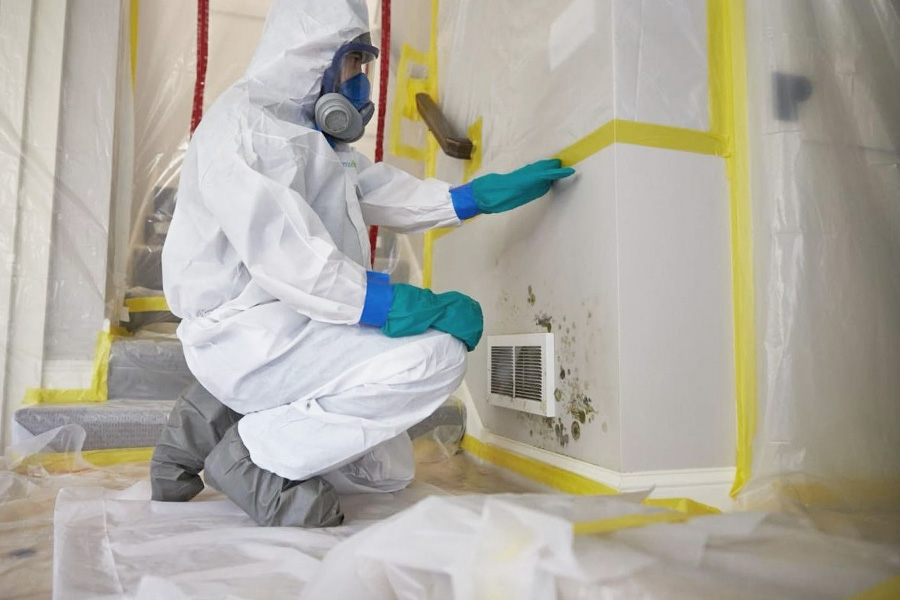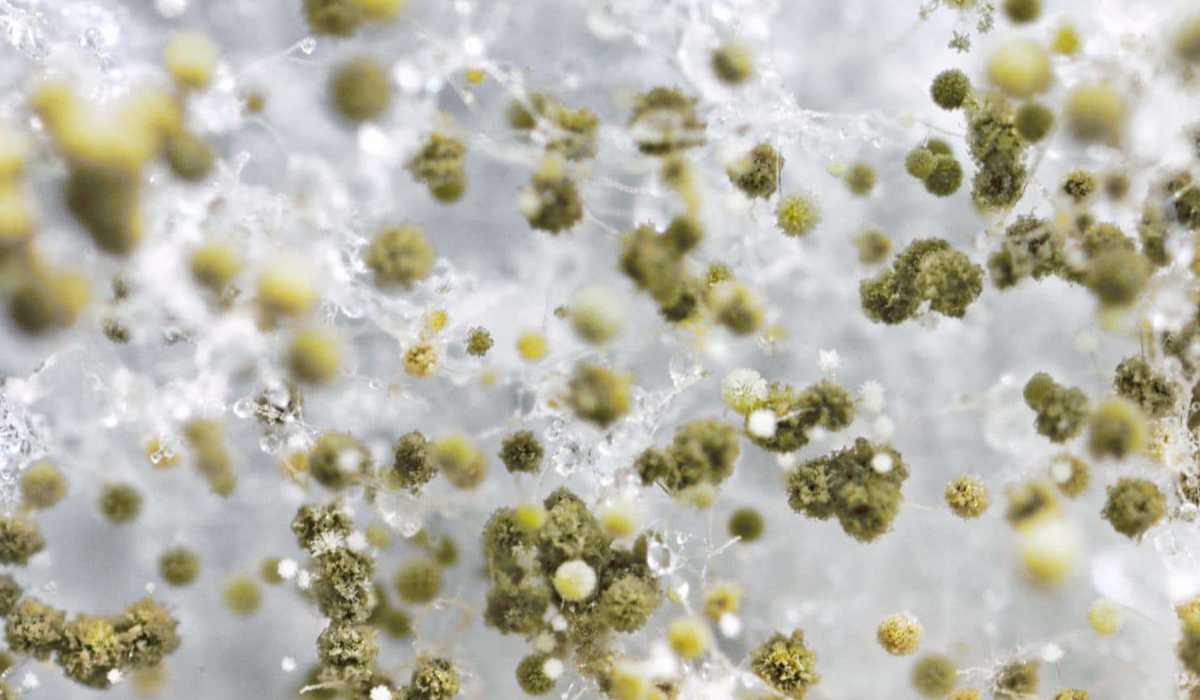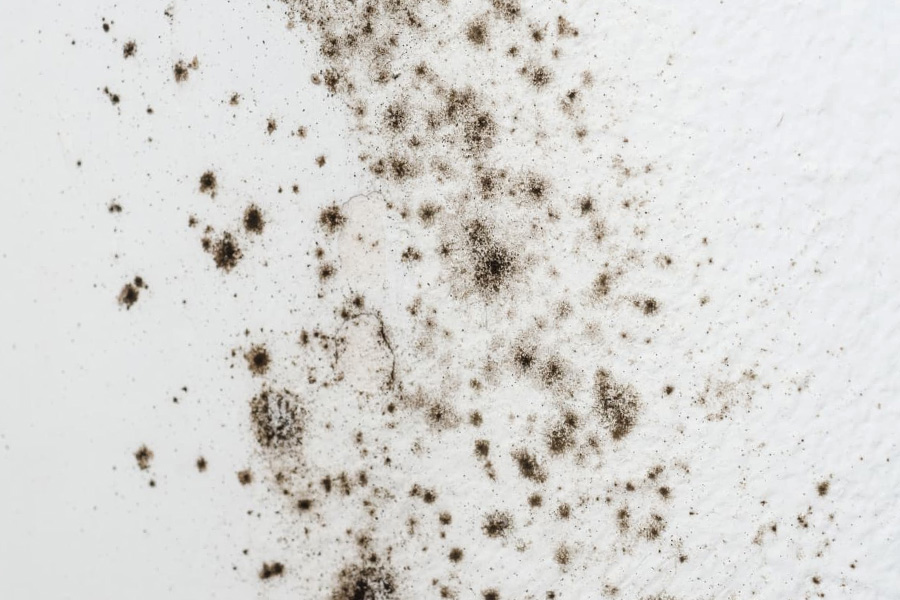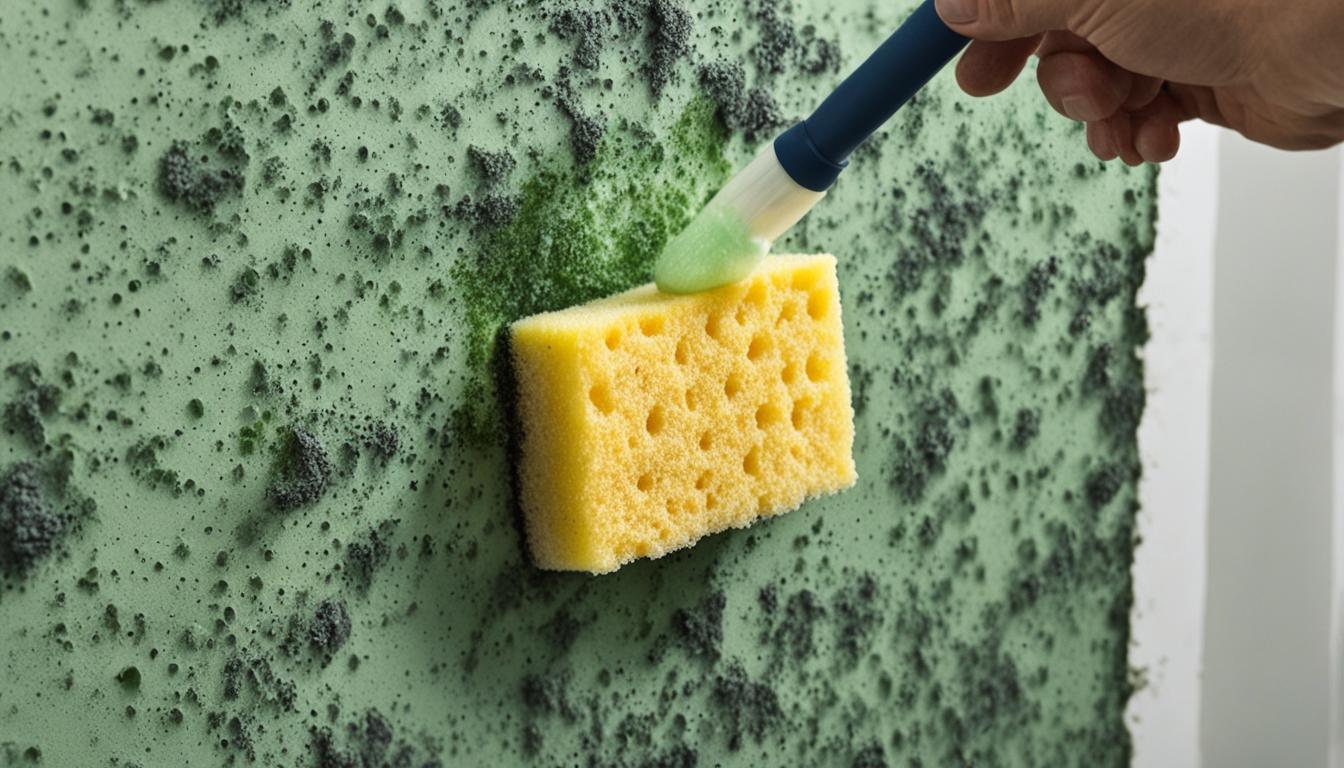
Pro Tips for Cleaning Mold Off Walls Safely & Effectively
The Importance of Removing Mold from Walls
Mold is a common problem that can grow on walls and other surfaces, particularly in areas with high humidity. It not only looks unsightly but can also pose a serious health risk, causing issues like allergies, asthma attacks, and other respiratory problems.
That’s why it’s crucial to remove mold from walls promptly and effectively. There are various mold removal techniques to consider, but not all of them are equally effective. To ensure the best results, it’s recommended to choose the best way to clean mold off walls according to the type and extent of mold infestation.
While DIY mold removal is possible with the right tools and techniques, professional mold removal services may be necessary in severe cases. Professional mold remediation methods can ensure that the mold is safely and thoroughly removed, preventing future growth and potential health risks.
So if you’re dealing with mold growth on your walls, it’s essential to address the problem as soon as possible with the best mold removal techniques available.
Tips for Removing Mold from Walls on Your Own
Mold growth on walls can be a significant issue for homeowners, but it doesn’t necessarily require professional intervention. Here are some tips for safely removing mold from walls on your own:
- Protect yourself: Wear protective gear such as gloves, goggles, and a face mask to prevent inhalation and skin exposure to mold spores.
- Identify the cause: Once you’ve discovered mold growth, it’s essential to address the underlying cause, such as a leak or excess moisture.
- Dry the area: Using a dehumidifier or fan, dry the affected area before attempting to clean the mold.
- Clean the mold: Use a solution of water and bleach or vinegar to wipe away visible mold growth. Alternatively, you can use a commercial mold cleaner or a mixture of borax and water.
- Discard contaminated materials: Any materials that cannot be thoroughly cleaned, such as drywall or carpeting, should be discarded and replaced.
- Prevent future growth: To prevent future mold growth, ensure proper ventilation, fix any leaks promptly, and maintain appropriate humidity levels.
These tips for DIY mold removal can be effective for small, isolated areas of mold growth on walls. However, if the mold growth is extensive or recurring, it’s best to consult with a professional mold remediation company for comprehensive and safe removal.
Important note: When cleaning mold off walls, avoid using a wire brush or abrasive cleaner, as these can release mold spores into the air and exacerbate the problem.
The Best Cleaning Solutions for Mold Removal
When tackling mold growth on walls, it’s essential to use effective cleaning solutions that can eliminate mold spores and prevent future growth. Here are some of the most effective cleaning solutions for removing mold from walls:
| Cleaning Solution | Pros | Cons |
|---|---|---|
| Bleach & Water | Effective at killing mold spores | Can damage some surfaces and release harmful fumes; must be used in a well-ventilated area |
| Vinegar & Water | Natural, non-toxic, and safe for most surfaces | May not be as effective as bleach or commercial mold cleaners |
| Commercial Mold Cleaners | Specifically designed to eliminate mold spores; can be effective on tough stains | May contain harmful chemicals, so must be used in a well-ventilated area |
| Borax & Water | Effective at removing mold and inhibiting future growth; natural and non-toxic | May require multiple applications and scrubbing; can be abrasive on some surfaces |
When using any of these cleaning solutions, be sure to test them on an inconspicuous area of the wall first to avoid any damage. Additionally, be sure to follow the instructions carefully and wear protective gloves, goggles, and a mask to prevent exposure to harmful fumes or skin irritation.
The Benefits of Hiring a Professional Mold Remediation Company
Mold infestations can be challenging to tackle on your own. Not only can mold be harmful to your health, but it can also spread quickly and be challenging to eliminate entirely. That’s where professional mold remediation services come in. Hiring a professional team ensures that the job is done right the first time and that the mold is eradicated completely.
Professional mold removal services use innovative techniques and tools that are not available to the general public. They also have the expertise and knowledge to determine the extent of the infestation and develop a comprehensive plan to get rid of the mold entirely. Additionally, professional mold remediation companies are equipped to handle large-scale mold infestations that may be difficult for homeowners to manage on their own.
When you enlist the help of a professional mold remediation company, you can rest assured that your home will be restored to its mold-free state quickly and efficiently. You can also benefit from the peace of mind that comes with knowing that your home is safe and free from mold.
Methods and Techniques Used by Professional Mold Remediation Companies
Professional mold remediation companies use various methods to remove mold from walls and other surfaces. These include:
| Method | Description |
|---|---|
| HEPA Vacuuming | Specialized vacuums equipped with HEPA filters are used to remove mold spores from surfaces and the air. |
| Dry Ice Blasting | Dry ice particles are blasted onto surfaces at high speeds to remove mold without causing damage to the surface. |
| Chemical Treatments | Professional-grade cleaners and chemicals are used to remove mold stains from walls and other surfaces. |
Professional mold remediation companies may also use moisture meters and hygrometers to assess moisture levels in your home to identify the source of the moisture causing the mold growth. They can then take steps to address the issue and prevent mold reoccurrence.
Overall, the benefits of hiring a professional mold remediation company for mold removal far outweigh the cost of their services. With their expertise, experience, and state-of-the-art tools, you can be confident that your home is in good hands and that the mold will be eliminated entirely.
How to Prevent Mold from Growing on Walls
Mold growth on walls can lead to serious health issues and costly repairs. Prevention is key when it comes to mold remediation. Here are some tips to prevent mold from growing on your walls:
- Control moisture levels: Mold thrives in humid environments, so keeping indoor humidity below 60% is crucial. Use a dehumidifier in damp areas and fix any water leaks or condensation issues promptly.
- Improve ventilation: Ensure proper ventilation in your home by opening windows, using exhaust fans in bathrooms and kitchens, and avoiding overstuffing closets.
- Use mold-resistant products: When remodeling or building, consider using mold-resistant drywall, paint, and insulation.
- Clean and dry up spills immediately: Quickly clean up any spills or leaks to prevent moisture from settling into walls.
By following these preventive measures, you can ensure that your walls remain mold-free and healthy.
Learn More About Mold Remediation Techniques
While preventing mold growth is important, it is sometimes inevitable. To learn more about the best way to clean mold off walls and mold remediation methods, read our other sections in this article.
Recognizing the Signs of Mold Infestation
When it comes to removing mold from walls, early detection is key. It’s essential to be able to recognize the signs of a mold infestation in your home. Here are some indicators to look out for:
- Visual signs: Look for discoloration, usually black or green, on walls and other surfaces. Mold can appear as spots or patches, and may cause the affected area to appear fuzzy or slimy.
- Olfactory signs: Mold has a musty, pungent odor that is often described as earthy or damp. You may be able to smell mold before you see it.
- Physical signs: If you or your family members are experiencing unexplained respiratory issues, allergies, or other health problems, it could be a sign of mold infestation in your home. Mold spores can cause a variety of health issues, and it’s important to address the problem promptly and properly.
If you have noticed any of these signs of mold growth on your walls, it’s time to take action. The best way to clean mold off walls will depend on the severity of the problem and the type of walls you have. In some cases, it may be best to hire a professional mold remediation company to ensure the problem is eradicated effectively.
Removing Mold from Painted Walls: Step-by-Step Guide
If you’ve noticed mold stains on your painted walls, you can still take action to remove them without damaging the surrounding paint. Here is a step-by-step guide:
- Wear protective gloves, goggles, and a mask to avoid contact with mold spores.
- Use a mixture of one-part bleach to three-parts water. If you prefer using a natural alternative, you can use white vinegar instead.
- Saturate a clean cloth in the solution and gently rub the mold stains. Avoid scrubbing vigorously, since it can damage the paint surface.
- Rinse the area thoroughly with a clean damp cloth, ensuring that no bleach solution remains on the painted surface.
- Let the wall dry completely. If any mold stains persist, repeat the process as needed.
- To prevent future mold growth, improve ventilation in the room and monitor humidity levels.
Using this guide, you can safely eliminate mold stains from painted walls and restore the look of your home. Remember to always take the necessary precautions and seek professional help if the mold infestation is extensive.
Safely Cleaning Mold Off Wallpapered Walls
If you notice mold growth on your wallpapered walls, it’s essential to clean it safely and effectively to prevent further damage. Here are some proper techniques to remove the mold while preserving the integrity of your wallpaper:
- First, put on protective gear, including gloves, goggles, and a mask, to avoid breathing in spores or exposing your skin to mold.
- Next, isolate the affected area by closing the door and covering any vents or openings to prevent the spread of mold spores.
- Before starting, test the cleaning solution on an inconspicuous area to ensure it won’t damage the wallpaper.
- Mix a solution of water and either vinegar or bleach, depending on the severity of the mold growth. For mild cases, vinegar is adequate, but for severe cases, bleach may be necessary.
- Apply the solution to the affected area using a moistened sponge, starting at the top and working your way down.
- Gently scrub the area, being careful not to damage the wallpaper’s surface.
- Rinse the sponge frequently, and replace it as needed to prevent the spread of mold spores.
- After cleaning, rinse the area with water and dry it thoroughly using a clean towel or fan.
- Dispose of any contaminated materials, such as sponges or towels, immediately.
Remember, if the mold growth on your wallpapered walls is extensive or covers a large area, it’s best to call in a professional mold remediation company.
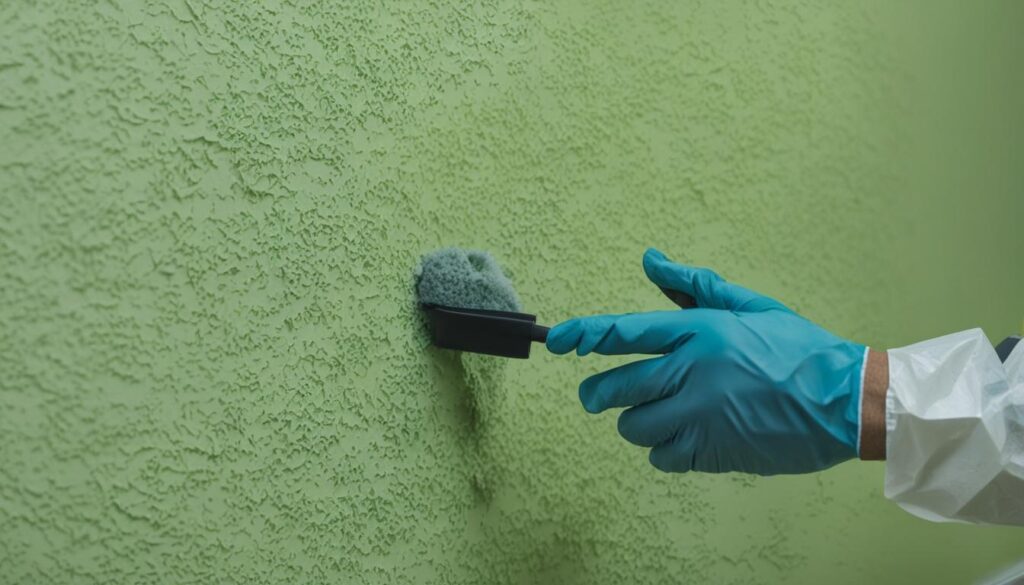
How to Tackle Stubborn Mold Stains on Walls
Despite your best efforts, sometimes mold stains can be particularly stubborn and difficult to remove. However, with the right techniques and tools, you can successfully eliminate these unsightly marks from your walls.
One effective method is to use a specialized mold cleaner. These cleaners are formulated to penetrate deep into the porous surfaces of walls and break down mold at the source. Look for products that contain active ingredients like bleach, hydrogen peroxide, or vinegar.
Alternatively, you can utilize natural remedies to combat mold stains. One option is to mix equal parts white vinegar and baking soda to create a paste. Apply the paste to the affected area and let sit for 10-15 minutes before rinsing with warm water.
Another natural solution is to use grapefruit seed extract. Mix 20 drops of extract with 2 cups of water and spray onto the mold stain. Allow the mixture to sit for several minutes before wiping clean with a damp cloth.
Whatever method you choose, be sure to wear protective gear such as gloves, goggles, and a mask to avoid inhaling mold spores. Additionally, be careful not to damage the surface of the wall while scrubbing away mold stains.
By utilizing these effective mold removal techniques, you can successfully eliminate stubborn mold stains and keep your walls looking clean and healthy.
Mold Removal Techniques for Different Types of Wall Materials
While mold can grow on any type of wall material, different surfaces require specific handling methods to ensure effective mold removal. Here are some mold removal techniques based on different wall materials:
Drywall
Drywall can be especially susceptible to mold growth due to its porous nature. Hence, when cleaning a drywall you must be careful not to soak the wall. Follow these steps when cleaning mold off of drywall:
- Put on protective gear and ventilate the room.
- Isolate the affected area by covering vents and doorways.
- Use a dry cleaning method like HEPA vacuuming to remove mold spores.
- Use a non-ammonia cleaner or white vinegar solution to gently scrub the mold off the surface.
- Allow the wall to dry completely before repainting.
Concrete
Concrete walls can be particularly challenging to clean due to their rough surfaces. Here are the steps to remove mold from concrete walls:
- Wear protective gear, including goggles and gloves.
- Vigorously scrub the affected area using a non-abrasive cleaner and a stiff-bristled brush.
- Rinse the area thoroughly with warm water and a clean cloth.
- Repeat the process if necessary until the mold is gone.
- Ensure the area is well ventilated to prevent future mold growth.
Wood
Mold on wood surfaces must be addressed quickly to avoid structural damage. Follow these steps to safely remove mold from wood:
- Put on protective gear and cover the floor and any furniture in the vicinity.
- Remove any surface mold using a HEPA filtered vacuum, clean cloth, or stiff-bristled brush.
- Gently sand the area to remove any remaining mold stains.
- Wipe down the surface with a wood cleaner solution to disinfect the surface.
- Allow the surface to dry properly before refinishing it.
Remember, the success of mold removal from any surface depends on the extent of the growth. Therefore, for extensive mold infestations, it is crucial to seek the services of professional mold remediation companies with the necessary equipment and expertise to ensure effective removal.
Maintaining Mold-Free Walls: Long-Term Preventive Measures
Preventing mold growth on walls is crucial to ensure a healthy living environment for you and your family. After effectively removing mold from walls, it’s essential to take long-term preventive measures to discourage future mold growth.

Regular Inspections
Regular inspections can help you identify any mold growth as soon as it appears, allowing you to take swift action before it spreads. Inspect your walls, ceilings, floors, and other areas susceptible to mold growth at least once a year. If you notice any signs of dampness or moisture, inspect the area more frequently.
Proper Ventilation
Proper ventilation helps to reduce humidity levels, preventing moisture buildup and mold growth. Make sure your bathroom and kitchen have exhaust fans that vent outside. Open windows and doors, especially when cooking or showering, to improve air circulation. If you live in a humid climate, consider using a dehumidifier to keep humidity levels in check.
Control Moisture Levels
Moisture is the primary factor that contributes to mold growth. Keep an eye on areas that tend to be particularly damp, such as basements, crawl spaces, and laundry rooms. Fix any water leaks or damage as soon as they occur to prevent mold growth. If necessary, use a waterproof coating on basement walls to prevent moisture penetration.
Maintain Your HVAC System
Regular maintenance of your HVAC system, including air ducts and filters, can help prevent mold growth. Replace air filters every 30-60 days to ensure proper air flow and reduce the risk of mold spores spreading through the ventilation system. Consider having air ducts professionally cleaned every three to five years to prevent mold growth in this hidden area.
By following these long-term preventative measures, you can create a healthy living environment and prevent the resurgence of mold growth on your walls.
Conclusion
Removing mold from walls is crucial for maintaining a healthy and safe living environment. DIY methods can be effective for minor mold growth, but severe cases require professional mold remediation services for complete eradication. Remember to take preventive measures to avoid mold growth, such as controlling moisture levels, fixing leaks promptly, and improving ventilation. If you suspect mold growth in your home, contact Fix Mold Miami for professional mold inspection services. Don’t compromise your health and well-being, act promptly to remove mold from your walls.
FAQ
Why is it important to remove mold from walls?
It is crucial to remove mold from walls promptly and effectively to prevent potential health risks. Exposure to mold can cause respiratory issues, allergies, and other health problems.
Can I remove mold from walls on my own?
Yes, you can remove mold from walls on your own. It is essential to follow proper cleaning techniques and use appropriate cleaning solutions and tools to ensure effective mold removal.
What are the benefits of hiring a professional mold remediation company?
Hiring a professional mold remediation company offers several advantages. Professionals have the expertise and equipment to thoroughly and efficiently remove mold. They can also identify and address the root cause of mold growth.
How can I prevent mold from growing on walls?
To prevent mold growth on walls, it is important to control moisture levels, improve ventilation, and address any water leaks or condensation issues promptly. Keeping humidity levels low and ensuring proper airflow can help deter mold growth.
How can I recognize the signs of a mold infestation?
Signs of mold infestation on walls include visible mold growth, a musty odor, and the presence of damp or discolored patches. If you experience unexplained allergies or respiratory symptoms, it may also indicate a mold problem.
How do I remove mold from painted walls?
To remove mold from painted walls, start by wearing protective gear and isolating the area. Scrub the moldy surface with a mixture of water and detergent, then rinse and dry thoroughly. Repaint the area if necessary.
How do I safely clean mold off wallpapered walls?
To safely clean mold off wallpapered walls, begin by isolating the area and wearing protective gear. Gently scrub the affected area with a mild cleaning solution suitable for wallpaper. Avoid saturating the wallpaper, as it can cause damage.
How can I tackle stubborn mold stains on walls?
Stubborn mold stains on walls can be treated with specialized mold cleaners or natural remedies like vinegar or hydrogen peroxide. Apply the chosen solution to the stain, scrub gently, and rinse thoroughly.
How do I remove mold from different types of wall materials?
The approach for cleaning mold off different wall materials may vary. For drywall, use a mixture of water and detergent or a specialized mold cleaner. Concrete walls can be scrubbed with a bleach solution. Wood walls may require sanding or refinishing in severe cases.
What are the long-term preventive measures to maintain mold-free walls?
To maintain mold-free walls, regularly inspect for moisture issues or leaks, ensure proper ventilation, and promptly address any dampness or water damage. Keep humidity levels low, use dehumidifiers if necessary, and promote adequate airflow.
How do I contact Fix Mold Miami for mold inspection services?
To schedule mold inspection services with Fix Mold Miami, please visit our website at www.fixmoldmiami.com or call our hotline at 123-456-7890. Our team of professionals is ready to assist you with all your mold remediation needs.

